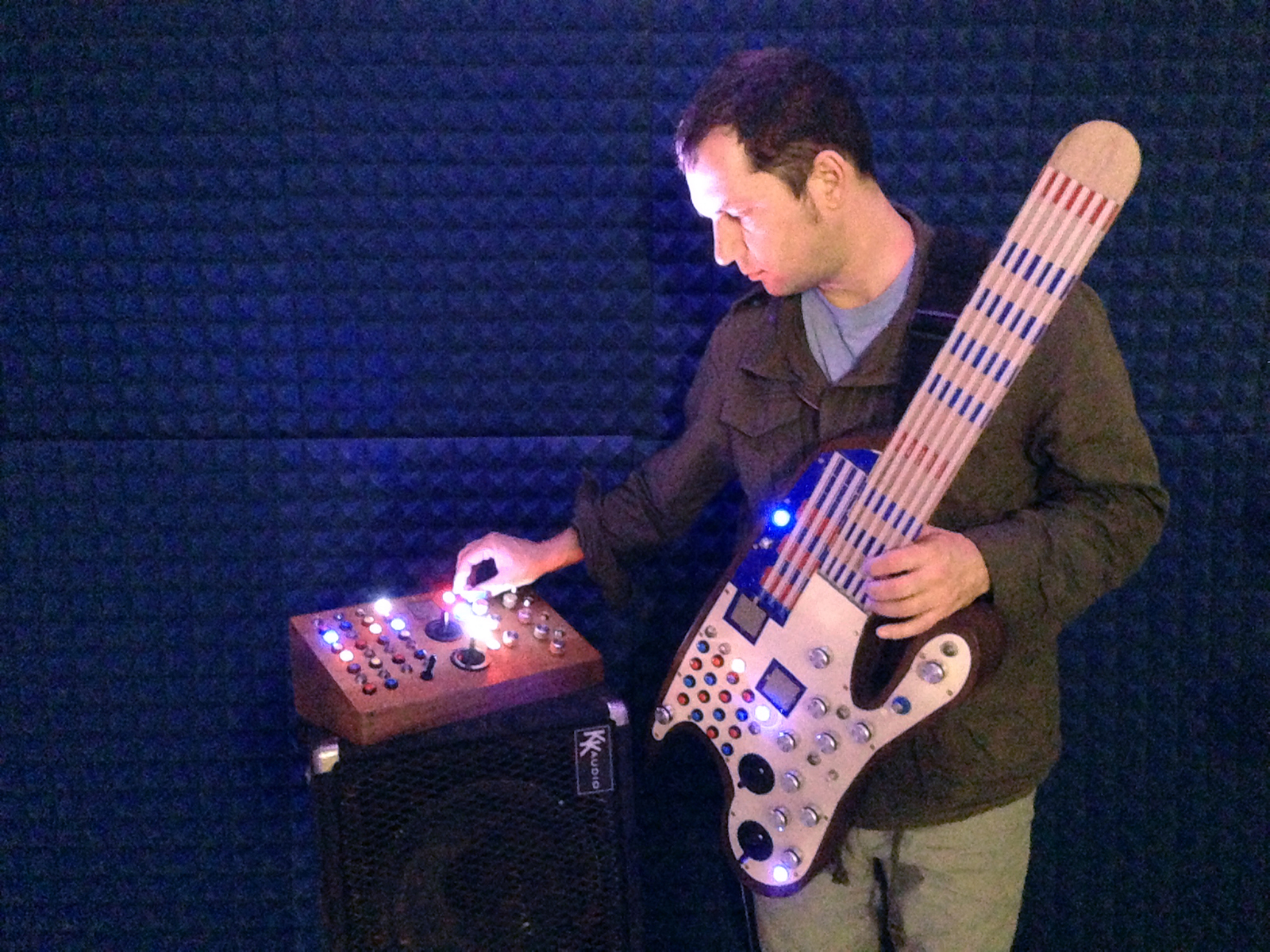Q&A: Instrument designer talks ABCs of MIDI device

Musician Nick Demopoulos created the SMOMID, or string modeling MIDI device (above), an instrument that emits light and sound. Demopoulos has developed four versions of the SMOMID since 2009. He will demonstrate the latest version at the Schoenberg Music Building Tuesday.
(Courtesy of Kara Kreider)
By Gail Acosta
Jan. 20, 2015 12:37 p.m.
Among being a musician and a composer, Los Angeles native Nick Demopoulos is a sound and instrument designer. In an attempt to mesh the computer and guitar, he has created the SMOMID, or string modeling MIDI device, an instrument that resembles the guitar but produces both light and sound.
Demopoulos has developed four versions of the SMOMID in the span of five years. He will demonstrate the latest version of his instrument Tuesday at the Schoenberg Music Building in cooperation with the UCLA Herb Alpert School of Music.
The Daily Bruin’s Gail Acosta spoke with Demopoulos about the origins of the SMOMID, the evolution of the instrument and his upcoming demonstration.
Daily Bruin: SMOMID stands for string modeling MIDI device. What does that mean?
Nick Demopoulos: It’s a device that has sensors on it that resemble a stringed instrument. MIDI device is something that sends MIDI information, which is a protocol language that almost any music software would understand. So you play it like a stringed instrument and then it spits out MIDI data, which you can use to control light, music, robotics – anything that can accept the information.
DB: What led you to create the SMOMID?
ND: I’m a guitar player and maybe about 15 years ago, I started really experimenting with electronics in guitar performance and then I started performing with a jazz electronic music group called Exegesis. And when we were in the performance, I started using my computer as well as my guitar. I was always trying to find a way to marry the two things but I found it really difficult and that’s what led me to develop the (SMOMID).
DB: You said that you wanted to marry the computer and the guitar, but why did you want to specifically create an instrument that emitted light and sound?
ND: The main thing was that as a guitar player, there’s no way to interface with a computer. As a keyboard player, there’s a lot of ways to interface. If you go to Guitar Center, there’s a DJ MIDI interface, there’s a keyboard MIDI interface, there’s even a drum MIDI interface. But I don’t think you’ll find any for the guitar so I decided to build my own. That way, with my guitar technique, I could actually speak with a computer.
DB: What type of sound is the instrument able to emit?
ND: The instrument itself isn’t emitting any sound; it’s just spitting out data. But I created a software that does something with data and, theoretically, you could make it sound close to a guitar. In my music, because it’s such a strange interface, I try to play really organic sounds so I sample a lot of Buddhist bells, Indonesian gamelan, throat singers from Mongolia and Byzantine monks. The (sounds) I create are inspired by a lot of retro sounds like the Moog (synthesizer) – vintage synthesizer sounds.
DB: Can you take me through the process of creating your first SMOMID?
ND: I got up at 9 in the morning and I would just construct it until I was too tired to stay awake every day for two weeks. It was a very raw instrument. In other words, it looked like it was just slapped together. It wasn’t pretty but it worked.
DB: What was the most challenging part of creating your instruments?
ND: I think the most challenging part, and it’s still the most challenging part today, is organizing everything inside of it and this is really important because if something breaks, you have to be able to replace it. So the most challenging part was organizing the wires, sensors and all the components.
DB: You said that there are four versions of the SMOMID, how do you think the instrument has evolved?
ND: Well the present version is the only one that has LED lights. So it evolved in that once I realized that I can get information from the instrument to the computer, I also realized that I could also get information out of the computer back to the instrument and that’s when I started incorporating the lights. The lights are basically the computer talking back to the instrument and giving me feedback. It also has a lot more sensors.
DB: What can UCLA students expect from your show on Tuesday?
ND: I think if anyone is curious about new developments in music technology and just technology in general – what you can do with a microcontroller and music – then I think they would be really interested. But if you’re just into retro, vintage sounds, from the 1970s and 1980s, and trippy, experimental music, I think you’d like it too.
Compiled by Gail Acosta, A&E; senior staff.


